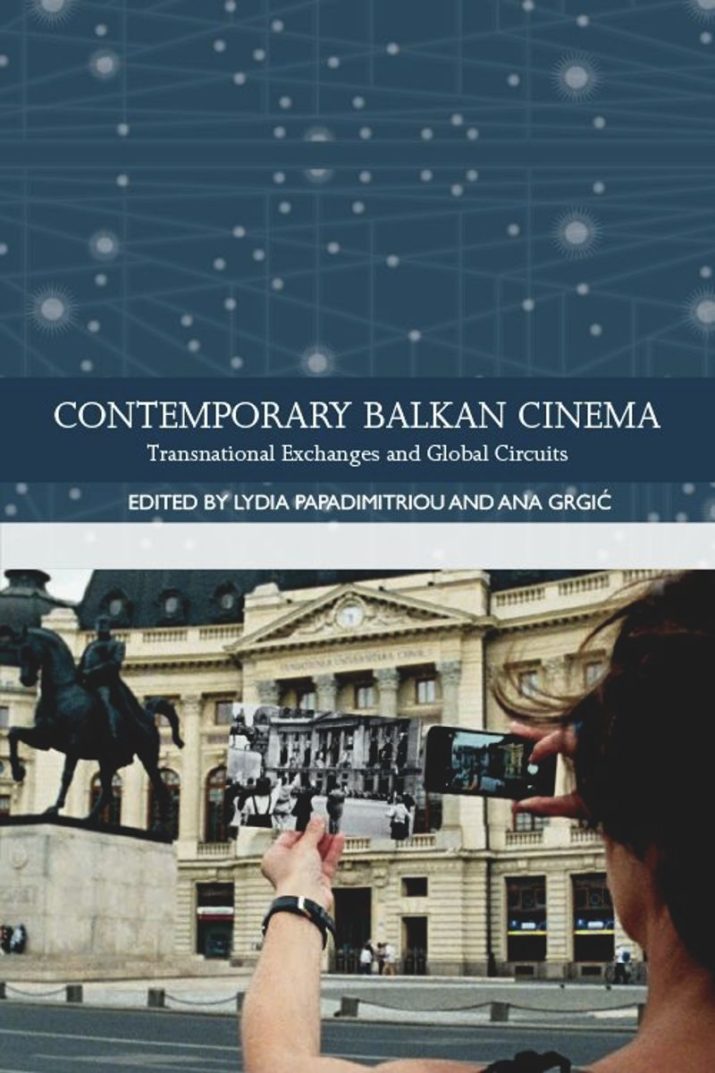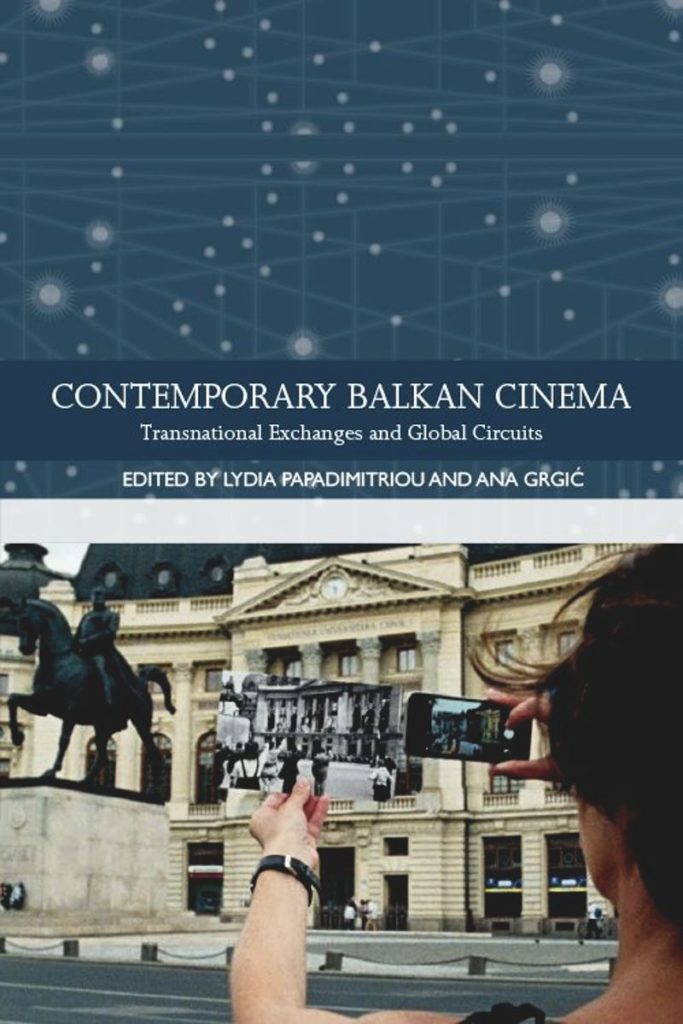
Contemporary Balkan Cinema: Transnational Exchanges and Global Circuits, edited by Lydia Papadimitriou and Ana Grgić

Since the early 2000s, film scholarship has embraced the transnational as a salient and more inclusive framework of scholarly analysis. It has provided new and original outlets for research into film culture as a whole, evading thus the narrow confines of film criticism, which looks at films solely for their content and artistry. Looking at cinema as culture with multiple sites of interaction, rather than the artistic expression of a sole creative genius, has also provided the critical impetus to tackle slippery notions of quality that have for long rested on the national and national cinema as stable categories. By casting a wider net in order to capture the transnational dimensions of films, we are able to engage with the entire spectrum of filmmaking from its production to its reception, reconceiving cinema as a site of cultural production and exchanges within and beyond the confines of nations. This permits researchers to underline the hybridity of films and to explore the discursive potentials of films, first and foremost, as coproductions involving a complex network of partners and stakeholders from several nations. This tendency has brought forth innovative research into the transnationalism of film festivals and significantly into small and transitional nations which lack the infrastructure for a functioning national film industry making thus coproduction a strategic necessity. Bearing this in mind, Contemporary Balkan Cinema: Transnational Exchanges and Global Circuits, edited by Lydia Papadimitriou and Ana Grgić (2020), follows from the influential collection by Mette Hjort and Duncan Petrie The Cinema of Small Nations (2007) as many of the authors in the former refer to Hjort and Petrie’s category, which finds some correspondence in the Balkan case studies. By underlining however the hybridity of Balkan film production and culture, the collection eschews from one singular framework making this an original contribution that pushes the envelope while remaining in dialogue with its antecedents.
Akin to contemporary Balkan film production, this collection of essays is also the result of transnational exchanges between academics and practitioners at the 2013 Divan Film Festival in Romania. As the editors mention, the fruitful coming together between guests from various parts of the Balkan Peninsula made it clear that cinema can help communicate across borders the many affinities Balkan neighbors share. Bearing this in mind, Contemporary Balkan Cinema helps build common ground in the Balkans through film scholarship. This achievement is two-fold. Not only does it involve actual in-depth research on the region’s cinematic landscape, but the essays are written by Balkan researchers representing each one of the region’s thirteen countries as though to indicate the meeting of all Balkan nations under a common semantic heading. More importantly, this collection makes a significant contribution to Anglophone film studies since some of the cinemas addressed here have only ever been discussed within their national context, an issue rectified by the contributing authors.
This publication breaks new ground in the study of Balkan and transnational cinema. From the offset, Papadimitriou and Grgić aim at reestablishing the notion of Balkan cinema as a whole “in order to take into account new geopolitical, institutional and technological circumstances” (2020, 2). By highlighting the transnational and cosmopolitan links in the production, distribution, and reception of contemporary Balkan films, the editors tackle negative associations that the very term “Balkan” has sprung up in mainstream discourse. They therefore set as a starting point of investigation and debate the blast of the global financial crisis in 2008 rather than the fall of communism in the 1990s. The latter is a stereotypical temporal designation that has for long dominated discussions on Balkan cinema and especially the cinema of the former Yugoslavia, which has been all too often conflated with Balkan cinema in international circles. This publication circumvents these constraints and illustrates Balkan cinema not merely as the sum of separate nations. On the contrary, as all contributing authors demonstrate, it involves a much wider web of relations between its member states and the rest of Europe, especially as the financial crisis forced filmmakers to seek new economic, political, and cultural alliances within and outside the Balkans. As a collection of essays on each cinema of the Balkans and on their transnational links that make Balkan cinema a meaningful category, this collection serves simultaneously as a scholarly study of national film industries (after all, transnationalism involves exchanges between nations) and as a wider reference text for both established researchers and students.
A case in point is Bruce Williams’ and Kledian Myftari’s essay on Albanian cinema. In their article, the authors demonstrate how Albanian cinema has achieved a more cosmopolitan status and thus entered “into a heretofore unfathomable two-way dialogue with the world beyond national borders” (Williams and Myftari 2020, 30). They trace the transforming landscape of Albania’s film industry in the last thirty years and showcase how policy makers, national funding bodies and regional festivals have helped expand the very definition of national cinema by pushing for an Albanophone cinema by Albanophone filmmakers from Kosovo, Macedonia, and Montenegro, while also facilitating opportunities for international filmmakers to make films in Albania and (partially) in the Albanian language, films often involving the struggles of Albanian migrants at home and away. Some of these films—and particularly the exchanges between Greece and Albania on the level of film production—are discussed in greater detail by Maria Chalkou in her chapter on Greek cinema. Both articles also raise important points on the diasporic, migrant and overall cosmopolitan belonging of contemporary Albanian filmmakers. Thanks to their original focus, the authors encourage readers to reconsider Albanian cinema as implicitly transnational and cosmopolitan. These attempts at reaching out beyond national borders have resulted in putting Albanian cinema and Albania on the map after decades of isolation.
Nevertheless, Albanian filmmakers struggle to maintain a steady output of films and what we call “Albanian cinema” is still moving through many hurdles in order to achieve a footing in the minds of domestic and international audiences. This is largely related to the painful transition of Balkan countries, like Albania, from communism to a market economy, a fact that makes some of these countries the poorest in the EU and nations of emigration. Although the many struggles of Balkan nations in the post-communist era have encouraged exciting alliances and an extrovert spirit, not to mention a surge in creativity and critical introspection in films per se, Balkan film industries are still in an anemic state and are active largely thanks to the support of EU funding initiatives like Eurimages and Fonds Sud. This is true about the cinema of Bosnia, “an extremely small film industry that takes shape in a society still struggling with its recent history of violent conflict” (Jelača 2020, 35), a fact that manifests in the content of many modern Balkan films, writes Dijana Jelača. The total lack of state-funded financial support in Bosnia makes its cinema essentially transnational “as both national borders and national identity appear unstable and unable to fully sustain the country’s cinematic output” (36). These issues are arguably valid in the case of Kosovo, which became independent from Serbia in 2008, when the global financial crisis erupted. What’s more, research on Kosovar cinema “is limited to a few pages in Robert Elsie’s Historical Dictionary of Kosovo (2011) or in popular travel guides” (Borrione and Muco 2020, 121), making the present edited volume all the more valuable, beside previous reference texts like Dina Iordanova’s The Cinema of the Balkans (2006).
The cinemas discussed here are determined by crisis and the end result is often linked to said crisis. This is largely the case with Greek cinema since 2008 as pointed out by Chalkou who outlines how filmmakers have renegotiated the national at a time “when the financial crisis, which hit the country particularly hard, reinforced nationalism and destabilised the Greeks’ sense of belonging to the European community” (Chalkou 2020, 100). In Greece, like in neighboring Bulgaria, a new generation of filmmakers have been willing “to work in a transnational competitive environment” (52) while new and heterogeneous cinephiles at home and abroad are increasingly keen on the art-house productions of unlikely candidates like Greece or Bulgaria. It is indeed a paradoxical fact that cultural production flourishes in times of financial crisis, political strife, and imbalance. This collection is dedicated to capturing and outlining all the parameters of this growing film culture in the Balkans since 2008 and to inviting scholars, practitioners and audiences to take part in a dialogue on the present and future of Balkan film production.
The transnational turn in European filmmaking and film studies has given renewed currency to peripheral cinemas and the opportunity to circumvent the western Eurocentric understanding of European cinema(s) and the hegemony of Hollywood in popular discourse. Contemporary Balkan Cinema: Transnational Exchanges and Global Circuits brings the aforementioned points into relief. It is a timely addition to steadily growing scholarship on emergent film cultures in Eastern Europe and the European South where the many exciting possibilities transnationalism can afford for both filmmaking and film scholarship materialize.
Philip E. Phillis is a lecturer in Film and Media Studies at Sciences Po Collège, Le Havre. He has extensively published on Greek cinema, European cinema, migrant representation and transnationalism. He is the author of Greek Cinema and Migration (1991-2016) (Edinburgh University Press, 2020).
Contemporary Balkan Cinema: Transnational Exchanges and Global Circuits
edited by Lydia Papadimitriou and Ana Grgić
Publisher: Edinburgh University Press
Hardcover / 328 pages / 2020
ISBN 9781474458436
References
Iordanova, Dina, ed. 2006. The Cinema of the Balkans. New York: Wallflower Press.
Hjort, Mette, and Petrie, Duncan, eds. 2007. The Cinema of Small Nations. Edinburgh: Edinburgh University Press.
Published on April 8, 2022




